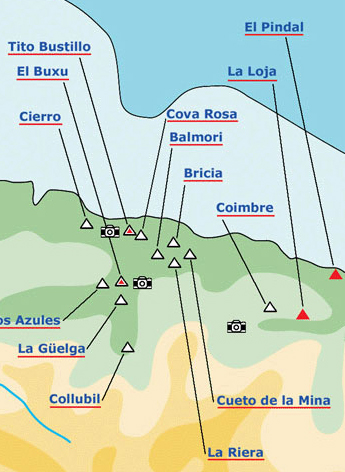Photo Archives: Paleolithic Art in Northern Spain
El Pindal
Preview Edition
- 15 photos(about1280x1000,1470x980/JPEG) and the 9 variations(about1280x1000/JPEG).
- Commentary by César González Sainz & Roberto Cacho Toca, Univ. of Cantabria.
- Royality Free for private and educational use.
In this downloadable photo archives are contained 15 photos and the 9 variations of Paleolithic cave art of El Pindal cave with the archeological data and commentary as shown in this preview pages. Only the small sized reference images and a part of commentary are shown in this preview edition, but if you are interested to see more and to use these photos, please go to Kagi store and purchase the data package. Once payment has been made at the Kagi store, you will receive an e-mail containing the URL to download the data package. All photos that are contained in this package are ROYALITY FREE for private and educational use.
 El Pindal Cave
El Pindal Cave
Cueva de El Pindal is situated by the San Emeterio Headland, near the village of Pimiango, in the eastern limits of the Principality of Asturias. The cave entrance, facing east, has a magnificent view of cliffs hanging over the Cantabrian Sea. However, the Paleolithic artists had a very different view from this same place, as the coast line was then several kilometers further north, due to the marine regression which took place in the last glaciation.
The topography of Cueva de El Pindal is quite simple. The cave is basically a single large gallery, with no side-passages, 360m long. This tube was once a natural resurgence for a stream, and a small stream still flows in the lowest part of the cave in wet weather conditions.
The cave art was discovered by H. Alcalde del Rio, one of the pioneers in the region, in April 1908, and so it was the first cave with Paleolithic art to be known in Asturias. The depictions are distributed in five parts of the cave. The first is nearly 120m from the entrance, on the left-hand wall of the passage. This is a horse's head, painted as an outline in red, and facing right. It shows certain conventions typical of Solutrean art (of between 21,000 and 16,500 BP), such as the lines indicating the limits of the mane.
Further inside the cave, about 240m from the entrance, we find a large panel nearly twenty meters long. This has about fifty figures, practically all the figures known in the cave, They are animals and abstract signs executed with a small number of technical procedures. The signs are the most homogeneous, as they are all painted in red.
----------------------------------
[ References]
Alcalde del Rio, H., Breuil, H., Sierra, L. 1911: Les cavernes de la region Cantabrique. Imp. A. Chene. Monaco.
Balbin Behrmann, R. de, Alcolea Gonzáez, J.J., Gonzáez Pereda, M.A. 1999: Une visión nouvelle de la grotte de El Pindal, Pimiango, Ribadedeva, Asturias. L'Anthropologie 103, pp. 51-92.
Fortea,J. 1992: Pindal (El). In: El Nacimiento del Arte en Europa. Unión Latina. pp.246-248.
Jordá Cerdá F., Berenguer Alonso, M. 1954: La cueva de El Pindal (Asturias). Nuevas aportaciones. Boletin del Instituto de Estudios Asturianos ,23, pp 3-30.
|
Photographed by Takeo Fukazawa & Co-Project Team of Texnai Inc. and the University of Cantabria
Comment by César González Sainz & Roberto Cacho Toca, Univ. of Cantabria
Texnai Inc.:
2-1, Udagawa-cho, Shibuya-ku, Tokyo, Japan. Tel:03-3464-6927 Fax:03-3476-2372
e-mail:info@texnai.co.jp
Copyright reserved by Takeo Fukazawa &Texnai, Inc., University of Cantabria, IPA
|
|